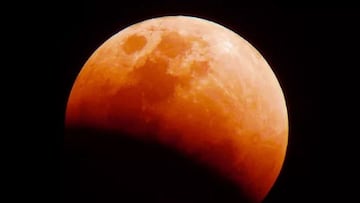Lunar eclipse today and ‘worm moon’: how and where it can be seen
The nighttime heavens offer a never-ending display of fantastic spectacles as part of a celestial ballet. One of them is set to take place tonight!

People across Mexico, the United States and Canada are preparing for one of the most spectacular celestial events that one can experience in their lifetime. On Monday 8 April there will be a total eclipse of the Sun which will be visible across a large swath of North America. It will last more than twice as long as the 2017 event that was visible in the US and the path of totality will be almost twice as wide.
However, as a prelude to that event, given the celestial ballet that is in constant motion above our heads of the tidy alignment between our Earth, Moon and Sun, it is no great surprise that another of the spectacles that captivates our attention and imagination will take place tonight.
Those that poise their gaze to the night sky on 24 March into the 25th, that are poised and ready will be able to take in what is known as the eclipse of the Worm Moon. The lunar eclipse, an eye-catching occasion where our satellite slips into the shadow of our planet as neatly as ballerinas in a tightly choreographed sequence, never fails to enthrall onlookers.
For those less familiar with the name and keen to learn more, let us explain.
Why is it called the Worm Moon?
The March full moon earned its peculiar moniker, the Worm Moon, for reasons deeply rooted in nature’s cycles. As winter fades and spring beckons, the earth awakens, and signs of life emerge from the thawing ground. This transition often coincides with the appearance of earthworms wriggling their way through the soil – a welcome sight for many, signaling the onset of spring gardening and agricultural activities.
But the naming conventions of celestial events vary across cultures, as space.com explains. Among North American Native peoples, for example, the March full moon holds diverse significance. For the Ojibwe (or Anishinaabe) peoples, this lunation is known as the Sugar Moon, marking the time when maple tree sap flows freely, ready to be harvested and transformed into sweet maple syrup. Additionally, this phase marks the Anishinaabe new year, symbolizing renewal and growth.
Meanwhile, the Tlingit people, whose cultural heritage spans the coastal regions of western Canada and Alaska, refer to the March full moon as Héentáanáx Kayaan’i Dís, which translates to “Underwater plants sprout.” This name underscores the ecological rhythms of their environment, highlighting the moment when aquatic vegetation begins to stir, heralding the changing seasons.
When can I see the March 2024 lunar eclipse?
So, now that you know what a Worm Moon is, let’s check out when our alarms need to be set for to not only see that, but also the eclipse.
For people in the United States, especially on the east coast, you’ll get to see this lunar eclipse early on 25 March 2024. The eclipse happens around the same time as the full moon, at about 3 a.m. Eastern Time. In places like New York City, you can see the moon rise on 24 March at 7:21 p.m., and the eclipse will start around 12:53 a.m., that is, shortly after midnight, lasting just over two hours till that maximal eclipse. The eclipse will end around 5:32 a.m., which is about an hour and a half before the moon sets at 7:02 a.m. Eastern Time.
Even though the eclipse is mainly visible from the Americas, Alaska, Antarctica, and parts of northern Russia, anyone around the world can watch it online through live streams and special programs about space. This means you don’t have to be in a specific geographical place to enjoy the magic of the lunar eclipse!






